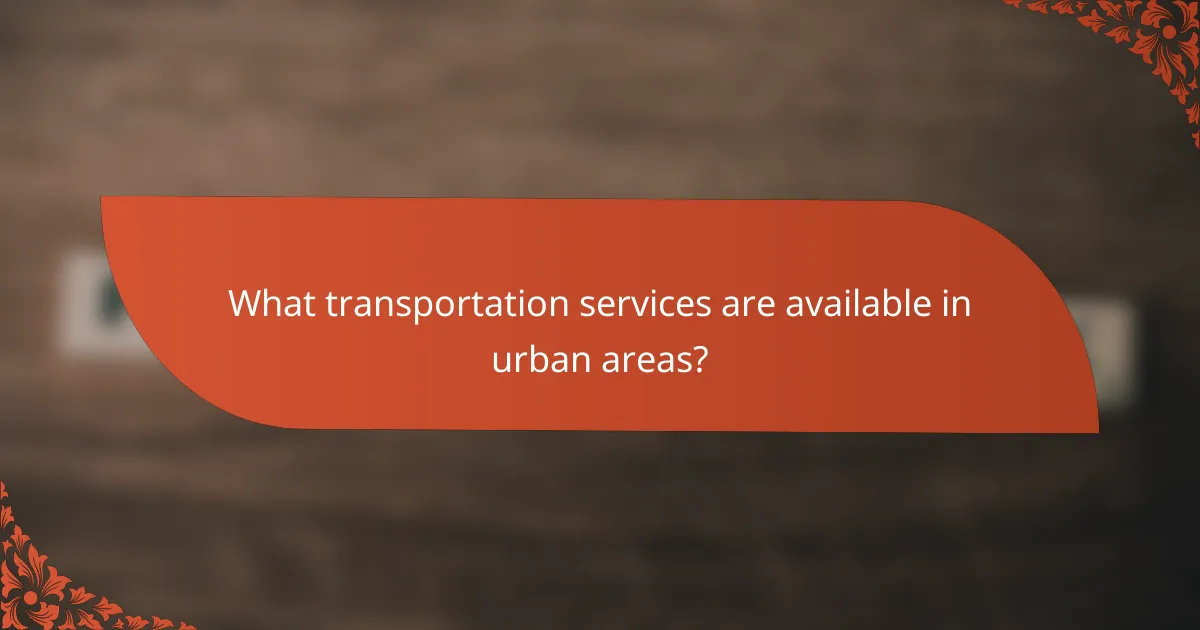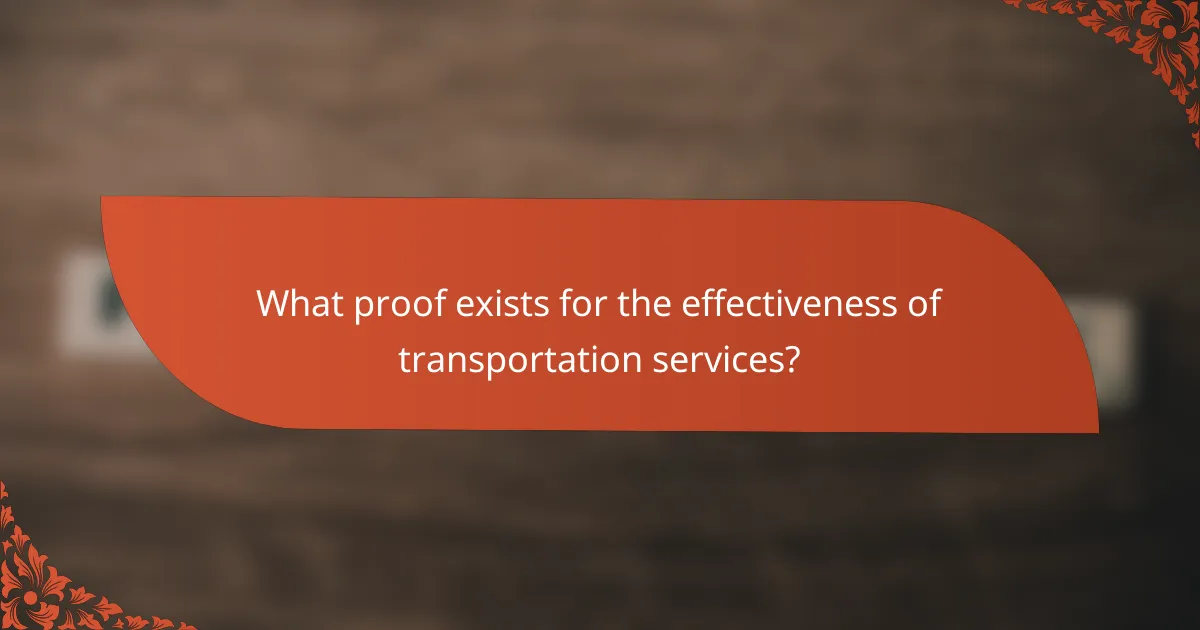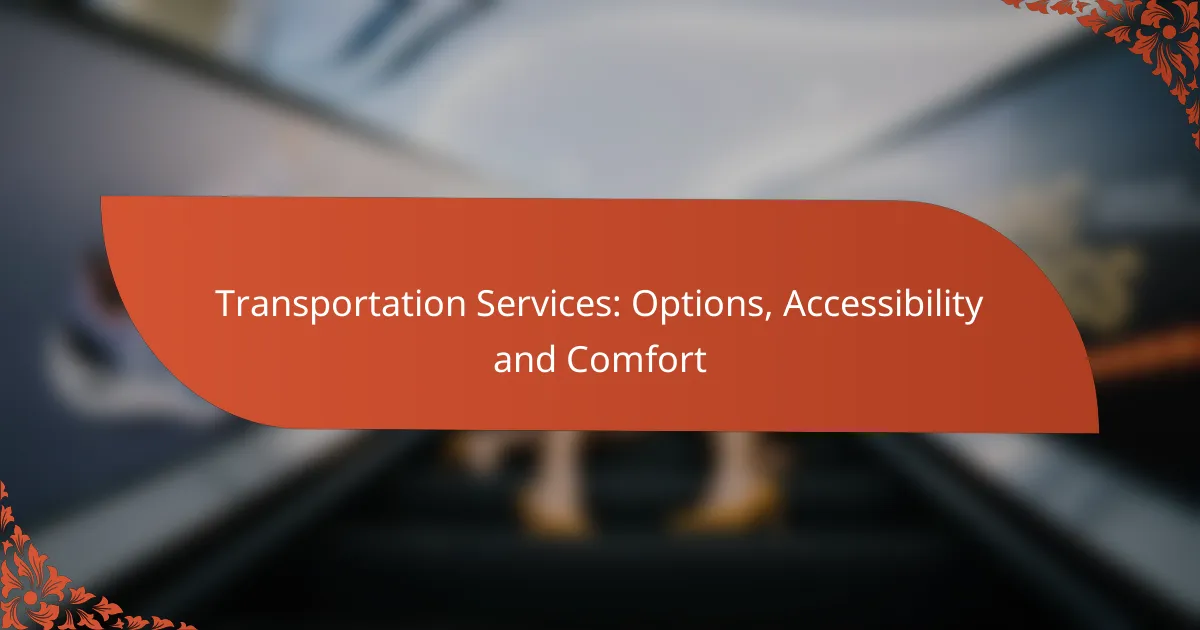Transportation services in urban areas provide a range of options to cater to diverse needs, including public transit, rideshare, and rental services. These choices vary in accessibility and comfort, ensuring that both residents and visitors can find suitable means of travel. Factors such as vehicle cleanliness, seating arrangements, and noise levels significantly influence the overall travel experience, making comfort an essential consideration for many passengers.

What transportation services are available in urban areas?
Urban areas typically offer a variety of transportation services to meet diverse needs, including public transit systems, rideshare options, taxi services, bicycle rentals, and car rental services. Each option provides different levels of accessibility, comfort, and cost, allowing residents and visitors to choose based on their preferences and requirements.
Public transit systems
Public transit systems, such as buses, subways, and trams, are essential for urban mobility. They often operate on fixed routes and schedules, making them a reliable choice for daily commutes. Fares usually range from a few dollars to a modest monthly pass, providing an economical option for frequent travelers.
When using public transit, consider peak hours when services may be crowded. Familiarizing yourself with the local transit app or website can help you plan your journey effectively and avoid delays.
Rideshare options
Rideshare services like Uber and Lyft offer convenient, on-demand transportation through mobile apps. Users can request a ride from their location and choose from various vehicle types, including standard, premium, or shared rides. Pricing is typically variable, influenced by demand and distance traveled.
To maximize savings, consider carpooling options or using rideshare services during off-peak hours. Always check the driver’s details and vehicle information for safety before getting in.
Taxi services
Taxi services remain a traditional option for urban transportation, available through street hails or phone apps. Taxis usually charge based on a meter system, which can vary by city, with base fares and additional charges for distance and time. In many cities, taxis are regulated to ensure safety and fair pricing.
When choosing a taxi, look for licensed vehicles and drivers. It’s advisable to confirm the fare estimate before starting your journey, especially in unfamiliar areas.
Bicycle rentals
Bicycle rentals are an eco-friendly transportation option in many urban areas, often facilitated by bike-sharing programs. These services allow users to rent bikes for short periods, typically charged by the hour or day. Many cities have dedicated bike lanes, enhancing safety and convenience for cyclists.
Before renting, check for available bike stations and any membership requirements. Wearing a helmet and following local cycling regulations can enhance your safety while riding.
Car rental services
Car rental services provide flexibility for those needing a vehicle for a short duration. Major rental companies operate in urban areas, offering a range of vehicles from economy cars to luxury options. Rental rates can vary widely based on the type of vehicle, rental duration, and insurance options.
When renting a car, review the rental agreement carefully, including fuel policies and mileage limits. Booking in advance can often secure better rates, especially during peak travel seasons.

How accessible are transportation services for individuals with disabilities?
Transportation services vary in accessibility for individuals with disabilities, with many options designed to accommodate their needs. Public transit systems, rideshare services, and specialized transport services play crucial roles in ensuring mobility for these individuals.
ADA-compliant public transit
ADA-compliant public transit refers to transportation systems that meet the standards set by the Americans with Disabilities Act. These systems typically include features like low-floor buses, elevators in train stations, and designated seating for individuals with mobility impairments.
When using public transit, individuals should check for specific accessibility features in their local transit authority. Many cities provide online resources or customer service numbers to assist with inquiries about accessible routes and services.
Accessible rideshare options
Accessible rideshare options are services that provide vehicles equipped to accommodate passengers with disabilities. Major rideshare companies often offer vehicles with wheelchair ramps or other accessibility features, allowing for easier entry and exit.
Users can usually request accessible vehicles through the app by selecting the appropriate option. It’s advisable to confirm the vehicle’s accessibility features upon booking to avoid any issues during pickup.
Specialized transport services
Specialized transport services cater specifically to individuals with disabilities, offering tailored solutions for their mobility needs. These services may include paratransit, which provides door-to-door transportation for those unable to use standard public transit.
Many communities have programs that offer subsidized or free rides for eligible individuals. It’s beneficial to research local options and understand the application process to access these services effectively.

What factors contribute to comfort in transportation services?
Comfort in transportation services is influenced by several key factors, including vehicle cleanliness, seating arrangements, temperature control, and noise levels. Each of these elements plays a significant role in enhancing the overall travel experience for passengers.
Vehicle cleanliness
Vehicle cleanliness is crucial for passenger comfort, as a clean environment promotes a sense of well-being. Regular cleaning schedules should be implemented to ensure that surfaces are sanitized and free from debris, especially in high-touch areas.
Passengers often assess cleanliness based on visible surfaces, such as seats and windows. Transportation providers should prioritize deep cleaning and maintenance to meet passenger expectations and enhance satisfaction.
Seating arrangements
Seating arrangements significantly impact comfort during travel. Adequate space between seats, legroom, and the ability to recline can greatly enhance the passenger experience. For instance, airlines often offer different classes with varying seat configurations to cater to different comfort levels.
When choosing transportation options, consider the seating layout. For longer journeys, services with more spacious seating or the option to upgrade can provide a more comfortable ride.
Temperature control
Temperature control is essential for maintaining comfort in transportation services. A well-regulated climate can prevent discomfort caused by extreme heat or cold. Most modern vehicles are equipped with climate control systems that allow passengers to adjust settings according to their preferences.
When traveling, check if the service offers individual temperature controls or if the temperature is set to a comfortable range, typically between 20°C and 24°C (68°F to 75°F). This can make a significant difference in overall comfort during the journey.
Noise levels
Noise levels within a vehicle can affect passenger comfort and concentration. High levels of noise can lead to fatigue and stress, while a quieter environment allows for relaxation and communication. Transportation services should aim to minimize noise through soundproofing and the use of quieter engines.
When selecting a transportation option, consider the noise levels associated with different vehicles. For example, trains are often quieter than buses, making them a preferable choice for longer trips if peace and quiet are a priority.

How to choose the right transportation service?
Choosing the right transportation service involves assessing various factors, including cost, convenience, and travel time. By evaluating these elements, you can select a service that best meets your needs and preferences.
Assessing cost-effectiveness
Cost-effectiveness is crucial when selecting a transportation service. Compare the total expenses, including base fares, surcharges, and any additional fees, to determine which option fits your budget. For instance, ride-sharing services may have lower upfront costs but could incur higher fees during peak hours.
Consider alternatives like public transportation, which often offers lower fares but may require more time and planning. Always check for discounts or passes that can reduce costs, especially for frequent travelers.
Evaluating convenience
Convenience encompasses factors like availability, ease of booking, and proximity to your location. Services that offer app-based booking and real-time tracking can enhance your experience by making it easier to arrange rides on the go. For example, taxis and ride-sharing apps typically provide quicker access compared to public transit.
Additionally, think about the service’s operating hours and routes. Some options may not be available late at night or in certain areas, which could impact your travel plans. Always choose a service that aligns with your schedule and location needs.
Considering travel time
Travel time is a critical factor in choosing a transportation service. Evaluate the estimated duration for each option, factoring in potential delays due to traffic or route changes. For instance, while a direct taxi ride may seem faster, public transport could be more time-efficient during rush hours due to dedicated lanes.
Using navigation apps can help you compare travel times across different services in real time. Keep in mind that the fastest option may not always be the most cost-effective, so weigh your priorities accordingly.

What are the pricing models for transportation services?
Transportation services typically use various pricing models, including flat-rate, metered, and subscription options. Each model has its advantages and considerations, impacting how customers pay for their travel.
Flat-rate pricing
Flat-rate pricing offers a fixed fee for a specific route or service, regardless of distance or time. This model is commonly used for airport transfers or rideshare services, providing predictability in costs.
For example, a flat rate from a city center to the airport might range from $30 to $50. Customers appreciate this model for its simplicity, as they know the total cost upfront without worrying about additional charges.
Metered pricing
Metered pricing charges customers based on the distance traveled or time taken, commonly seen in traditional taxis. This model can vary significantly depending on traffic conditions and the route taken.
In urban areas, metered fares may start at a base rate, with additional charges per mile or minute. While this can be economical for short trips, longer journeys may lead to higher costs, making it essential for customers to estimate their fare beforehand.
Subscription models
Subscription models provide customers with access to transportation services for a recurring fee, often appealing to frequent users. This can include monthly passes for public transit or rideshare services that offer unlimited rides within a certain period.
For instance, a monthly public transport pass might cost around $100, allowing unlimited travel within a city. This model can save money for regular commuters but may not be cost-effective for occasional users.

What proof exists for the effectiveness of transportation services?
Transportation services have demonstrated effectiveness through various studies and user feedback, showing improvements in accessibility, efficiency, and user satisfaction. These services often lead to reduced travel times and increased convenience for users across different regions.
Accessibility of Transportation Services
Accessibility in transportation services refers to how easily individuals can reach their destinations using available options. This includes considerations for people with disabilities, elderly individuals, and those in remote areas. Many cities have implemented regulations to enhance accessibility, such as the Americans with Disabilities Act (ADA) in the United States, which mandates accessible public transport.
To improve accessibility, transportation services may offer features like low-floor buses, audio announcements, and dedicated seating. Users should check local transportation websites for specific accessibility options available in their area, as these can vary widely.
Comfort in Transportation Services
Comfort in transportation services encompasses the quality of the ride, including seating, space, and overall environment. Factors such as vehicle cleanliness, temperature control, and noise levels significantly influence user comfort. For example, premium services like business class in trains or ride-sharing options can provide enhanced comfort compared to standard services.
When choosing transportation, consider the duration of your journey and the level of comfort you desire. For longer trips, opting for services that offer more space and amenities can make a significant difference in your travel experience. Always read reviews or ask for recommendations to find the most comfortable options available.










